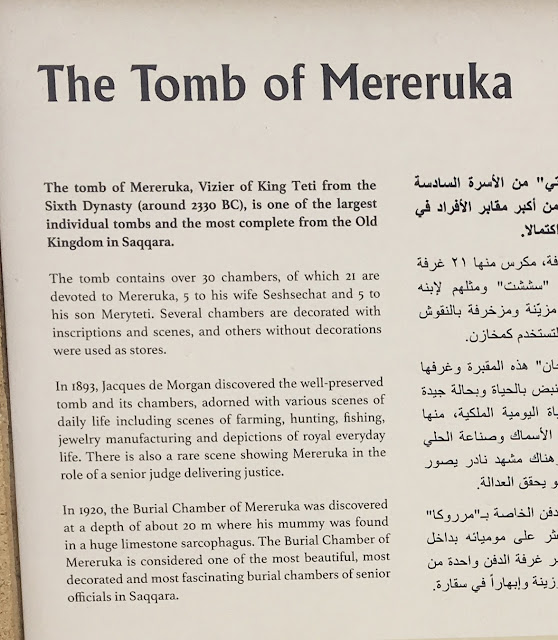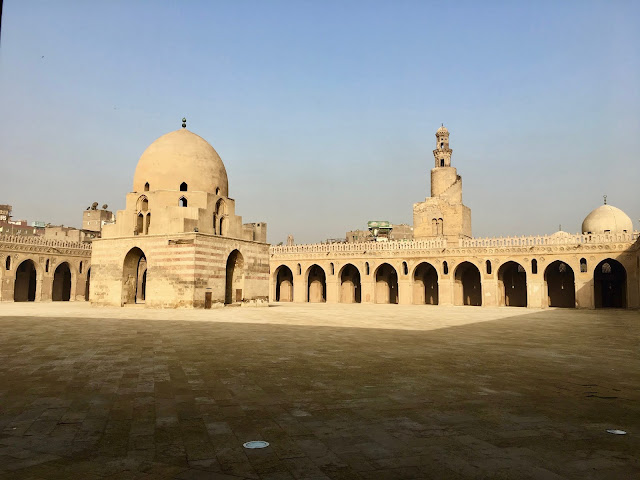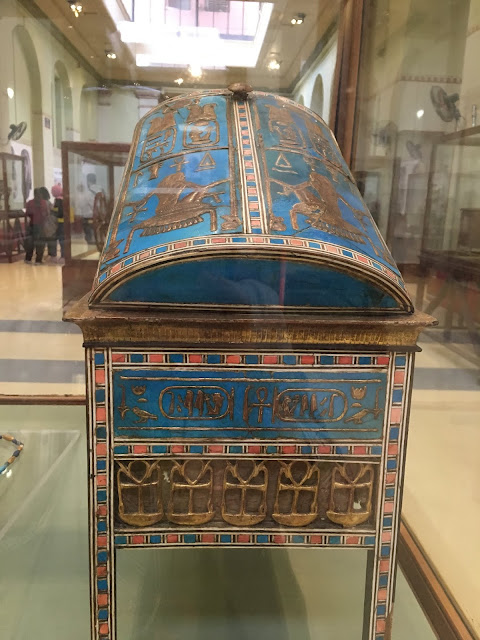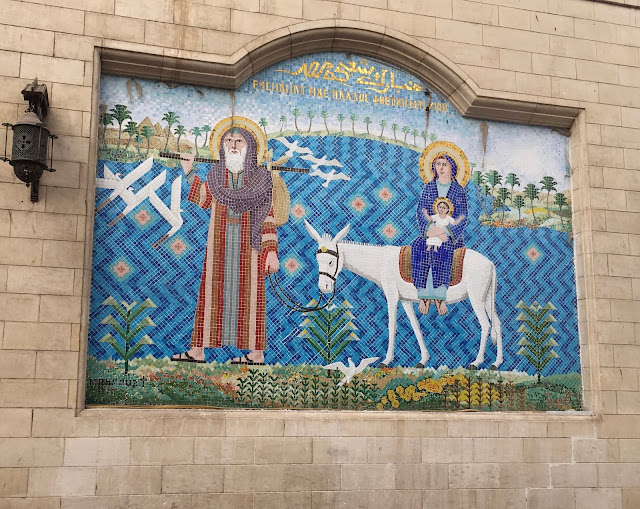Day 1
Our first stop was the royal necropolis (cemetery) of Dahshur. To get there, we drove out of Cairo along canals of the Nile River, the source of the Nile valley's fertile land for centuries.
In the desert, 25 miles south, we arrived at the first of many pyramids we would see on the trip. Nicknamed the "red pyramid" because it was constructed mainly of reddish limestone, it stands 30 story's high. Originally, it was covered with a white limestone casing which can be seen just above the ground level in the second photo, that also shows the remains of the funerary temple next to the pyramid.
The pyramid burial chamber is open to the public and can be reached by climbing up to the dark spot above and sightly to the left of my head in the first photo. Then one descends downward via a rather small passageway into the center of the pyramid. Here's the view looking down from the entrance, and then up towards the platform at the entrance.
The next pyramid we visited, which along with the red pyramid was built by King Senefru, is nicknamed the bent pyramid because of its shape. It is dated earlier than the red one, so many scholars think it was a first unsuccessful attempt at building a true pyramid.
The bent pyramid has more of its smooth facing stones still intact, so one can better imagine how these structures originally looked, gleaming in the desert sun.
A third pyramid at Dahfur is called the black pyramid. It originally had a white limestone casing as well, but was constructed of mud brick and clay -- not sturdy enough to withstand time, so it's mostly rubble today. You can see it in the distance below.
Next we drove to Sakkara, the burial ground for the ancient capital of Egypt at Memphis. Here, the earliest of Egypt's nearly 100 pyramids stands. Built by King Djoser (c. 2700 B.C.) it is called the step pyramid for obvious reasons. The Sakkara area served as a burial ground for numerous Egyptian kings, whose pyramids are in various states of disrepair or disintegration. The area also was used as a burial ground for various non royal high officials for the entire pharaonic period as well as a cemetery for the mummies of various sacred animals.
My first visit to Sakkara was when our sons were very young, and I remember being amazed at what is now called the Serapeum. Here the sacred mummified bulls were buried in enormous stone coffins or sarcophagi. This area has been fairly recently opened to visitors, after being closed for some 25 years for construction and excavation. It certainly has changed and been made more accessible since when we visited in 1990.
One of the largest and most complete tombs of non royal nobles at Sakkara is that belonging to Mereruka, the vizier of King Teti. It has over 30 chambers for himself, his wife, and his son. It has many well preserved paintings on some of the walls as well as carvings. Quite amazing, since its dated to c. 2330 B.C.
Ramses II was a great builder of temples and monuments throughout Egypt. We came across his work everywhere it seemed.
The last site we visited our first day was Abu Sir; however, because there is an active excavation in progress there, no one is allowed to trespass on the grounds. Fortunately, it gave us a view worth a photo.
Day 2
This day was spent in Cairo. We drove by the Saladin Citadel of Cairo to our first stop: the Ibn Tulun Mosque.
This is the oldest mosque (completed and consecrated in 879 A.D.) existing in original form and covers the largest area of any in Cairo. In order to keep the area clean, we all had to don large shoe covers, which made you feel a little like you were wearing snowshoes.
This is the main prayer niche (mihrab) of the mosque. Next to it is the minbar which is where the speaker at the mosque can be seen and more easily heard, especially in the days before electronic amplification.
The minaret is unique with is spiral staircase. There is debate whether or not it is part of the original construction as it isn't central to the construction of the rest of the mosque. We were permitted to climb it and got some excellent views of Cairo from there.
Next, we went to Bab Zuwayla, one of the three remaining gates of the old city walls of Cairo.
The gate has twin towers (minarets) which can be reached via steep stairs. From the top, panoramic views of Cairo can be seen.
Our final stop for the morning was the Mosque-Madrassa of Sultan Barquq, from the Mamluk era. It's completion date was 1386. Since the mosque is an active and conservative one, all the women needed to be appropriately covered with long skirts and head scarves to enter. All of us, male and female had to remove our shoes.
Both mosques we visited in Cairo were built in a square shape around a large courtyard. This one was paved with beautiful white stone tiles.
Inside the mosque, small groups were meeting with a teacher instructing them from the front. Others sat on the carpeted floor reading and praying. One felt there was a real sense of community in the place.
A beautifully decorated prayer niche.
Detail of the carpeting.
The afternoon of our second day was spent at the Egyptian Museum of Antiquities -- an enormous warehouse of absolutely amazing artifacts from all over Egypt. It's an overwhelming place, impossible to take in all at once.
Here are a few of the objects on the first floor.
This is the only complete statuette representation of King Khufu who built the Great Pyramid at Giza.
And here is Hatshepsut, who became queen of Egypt when at 12 years of age she married her half brother Thutmose II. When he died, she became regent for her stepson, Thutmose III who was just an infant. But later, she took on the role of Pharaoh, one of only three women to do so.
The top floor of the museum has several special exhibits which allow no photographs -- the treasures of Tutankhamun and the royal mummies. Both are amazing exhibits worth visiting. Fortunately, many of the finds from Tutankhamun's tomb are on display besides the "treasures" and are very beautiful as well.
Another very interesting exhibit on the second floor features mummies, sarcophagi, and buried artifacts of a couple whose tomb is also at the Valley of the Kings, where Tutankhamun's and many other pharaohs are. They are Yuya and Thuya (c. 1400 B.C.), the parents of the wife of Pharaoh Amenhotep II and the grandparents of Pharaoh Akhenaton.
Here are a few more photos that give you just a little sense of the quantity of what is in this amazing place.
Day 3
Our third day began with visiting Giza, the site of the most well-known of the pyramids. What a transformation this place has seen since 1990 when I visited before! First of all, Cairo has grown so it connects to Giza; whereas 29 years ago, there was green space between the two and they were two separate places. The infrastructure for tourism has replaced a place that you just drove up to emerging out of the desert. This photo angle gives the impression of what it used to be like.
The largest, Khufu's Great Pyramid, towers 481 feet above the plateau, has an estimated 2.3 million stone blocks, each weighing 2.5-15 tons depending on its size.
Included with the Great Pyramid complex is the Solar Boat Museum. This is built over the trench where the reconstructed funerary boat had been buried to accompany Khufu to the afterlife. The construction is of wood from Phoenicia and has no metal nails or screws, only wood and rope hold it together.
You can see better what it was like in this small model.
The smallest of the three major pyramids at Giza was built by the son of Khafre, Menkhaure, and is part of a complex including an extensive funerary temple. The pyramid's facade wasn't completed, but was intended to be smooth granite before the white limestone face was added. The lower part of this pyramid is fairly well-preserved.
The Giza complex has numerous other tombs which have been excavated as well as several smaller and crumbling pyramids which were built for the pharaohs' wives.
After visiting Giza, we headed back into Cairo to visit the Ben Ezra synagogue, the oldest synagogue in Cairo. According to local folklore, it is built at the site where baby Moses was found in the Nile.
Our final visit in Cairo was to what is commonly termed the "Hanging Church," though officially it is The Church of Virgin Mary. It is so called because it was constructed to literally hang above two towers from the ancient Roman fortress from 98 A.D.
The courtyard had several beautiful mosaics.
The pulpit had beautiful marble inlays.
This is looking down into the void between the two pillars upon which the church is built.
I wish only peace to the people of Cairo and all of Egypt. Salam.
Next stop, Luxor.
Next stop, Luxor.









































































































No comments:
Post a Comment